Green Transition: The Frontier of the Digicircular Economy Evidenced from a Systematic Literature Review
Abstract
:1. Introduction
1.1. Circular Economy in the Digital Age
1.2. Motivation of the Research
1.3. Aim and Structure of the Research
2. Rationale
3. Materials and Methods
3.1. Analytic Hierarchy Process (AHP) Method
- ‘Analytic’ or decompose the problem into its elementary components
- ‘Hierarchy’ or design the decision problem in a hierarchy defining the goal, criteria and the sub-criteria
- ‘Process’ the data and evaluations in order to achieve the final result
| A1 | A2 | … | Am | ||
| A1 | 1 | a12 | … | a1m | |
| A = aij= | A2 | 1/a12 | 1 | … | a2m |
| … | … | … | … | … | |
| Am | 1/a1m | 1/a2m | … | 1 |
| w1/w1 | w1/w2 | w1/wm | |||
| A1 | w2/w1 | w2/w2 | w2/wm | ||
| A= | A2 | ||||
| … | … | … | … | … | |
| Am | wm/w1 | wm/w2 | … | wm/wm |
3.2. Analytical-PRISMA (A-PRISMA) Approach
3.3. A-PRISMA Modeling
- RQ1. How relevant is the EU policy on circular economy in the digital age?
- RQ2. What digital technologies might promote the benefits of circular economy?
- RQ3. In a digital age how business models could impact on CE?
- RQ4. What is the contribution coming from RESOLVE framework?
- RQ5. Which SDGs are more involved on CE?
- Exclusion criteria definition (E). Documents were excluded according to the following exclusion criteria:
- E1: Documents not related to digital technologies.
- E2: Documents not related to CE.
- E3: Duplicate documents.
- E4: Documents in press.
- Inclusion criteria definition (I). Documents were included according to the following inclusion criteria:
- I1: Documents published only in English.
- I2: Documents published only in peer-reviewed international journals (not included conference proceedings; editorials, chapter books, etc.).
- Quality criteria definition (Q). Documents were analyzed according to the following quality criteria:
- Q1: Documents proposing different methodologies and approaches.
- Q2: Documents proposing different Enabling technology.
- Q3: Documents with impact factor, SJR or CiteScore.
4. Results
4.1. Studies Selected and Characteristics
4.2. Results of Individual Studies
- #1 RESOLVE Framework (10 documents)
- #2 EU Eco-innovation Plan (33 documents)
- #3 Digital Technologies (32 documents)
- #4 BUSINESS Models (14 documents)
- #5 SDGs (15 documents)
5. Discussion and Lessons learned
5.1. Main Contributions of the Research
5.2. Synthesis to Move from Theory to Practice
5.3. Challenges of Sustainability
6. Conclusions
6.1. Concluding Remarks
- The sustainable use of renewable resources. This means that the rate of use should be less than the rate at which resources are able to regenerate;
- The sustainable use of non-renewable resources, i.e., their depletion must be compensated for by switching to renewable resources
- A sustainable emission rate for pollution and waste. According to this principle, the pace of emissions and waste production should not be faster than the rate at which natural systems can absorb, recycle or render them harmless.
6.2. Limitations and Future Research Developments
Author Contributions
Funding
Institutional Review Board Statement
Informed Consent Statement
Conflicts of Interest
References
- Bressanelli, G.; Perona, M.; Saccani, N. Challenges in supply chain redesign for the Circular Economy: A literature review and a multiple case study. Int. J. Prod. Res. 2018, 57, 7395–7422. [Google Scholar] [CrossRef] [Green Version]
- Cioffi, R.; Travaglioni, M.; Piscitelli, G.; Petrillo, A.; Parmentola, A. Smart Manufacturing Systems and Applied Industrial Technologies for a Sustainable Industry: A Systematic Literature Review. Appl. Sci. 2020, 10, 2897. [Google Scholar] [CrossRef] [Green Version]
- Zacharias, J. Addressing Global Climate Change with Big Data-Driven Urban Planning Policy. Int. J. E-Planning Res. 2021, 10, 1–16. [Google Scholar] [CrossRef]
- Cetin, S.; De Wolf, C.; Bocken, N. Circular digital built environment: An emerging framework. Sustainability 2021, 13, 6348. [Google Scholar] [CrossRef]
- Nikolaou, I.E.; Tsagarakis, K.P. An introduction to circular economy and sustainability: Some existing lessons and future di-rections. Sust. Product. Consumpt. 2021, 28, 600–609. [Google Scholar] [CrossRef]
- Idrissi, N.; Zellou, A. A systematic literature review of sparsity issues in recommender systems. Soc. Netw. Anal. Min. 2020, 10, 15. [Google Scholar] [CrossRef]
- Pieper, D.; Mathes, T.; Eikermann, M. Impact of choice of quality appraisal tool for systematic reviews in overviews. J. Evid. Based Med. 2014, 7, 72–78. [Google Scholar] [CrossRef] [PubMed]
- Kitchenham, B. Procedures for Performing Systematic Reviews; Keele University Technical Report TR/SE-0401; Keele University: Keele, UK, 2004; ISSN 1353–7776. [Google Scholar]
- Saaty, T.L. Modeling unstructured decision problems—The theory of analytical hierarchies. Math. Comput. Simul. 1978, 20, 147–158. [Google Scholar] [CrossRef]
- Saaty, T.L. Applications of analytical hierarchies. Math. Comput. Simul. 1979, 21, 1–20. [Google Scholar] [CrossRef]
- Ghisellini, P.; Cialani, C.; Ulgiati, S. A review on circular economy: The expected transition to a balanced interplay of envi-ronmental and economic systems. J. Clean. Prod. 2016, 114, 11–32. [Google Scholar] [CrossRef]
- Contreras-Lisperguer, R.; Muñoz-Cerón, E.; Aguilera, J.; de la Casa, J. A set of principles for applying Circular Economy to the PV industry: Modeling a closed-loop material cycle system for crystalline photovoltaic panels. Sustain. Prod. Consum. 2021, 28, 164–179. [Google Scholar] [CrossRef]
- Tapia, C.; Bianchi, M.; Pallaske, G.; Bassi, A.M. Towards a territorial definition of a circular economy: Exploring the role of territorial factors in closed-loop systems. Eur. Plan. Stud. 2021, 29, 1–20. [Google Scholar] [CrossRef]
- Velvizhi, G.; Shanthakumar, S.; Das, B.; Pugazhendhi, A.; Priya, T.S.; Ashok, B.; Nanthagopal, K.; Vignesh, R.; Karthick, C. Biodegradable and non-biodegradable fraction of municipal solid waste for multifaceted applications through a closed loop integrated refinery platform: Paving a path towards circular economy. Sci. Total Environ. 2020, 731, 138049. [Google Scholar] [CrossRef] [PubMed]
- Atabaki, M.S.; Mohammadi, M.; Naderi, B. New robust optimization models for closed-loop supply chain of durable products: Towards a circular economy. Comput. Ind. Eng. 2020, 146, 106520. [Google Scholar] [CrossRef]
- Vanhamäki, S.; Virtanen, M.; Luste, S.; Manskinen, K. Transition towards a circular economy at a regional level: A case study on closing biological loops. Resour. Conserv. Recycl. 2020, 156, 104716. [Google Scholar] [CrossRef]
- Lejarazu-Larrañaga, A.; Molina, S.; Ortiz, J.M.; Navarro, R.; García-Calvo, E. Circular economy in membrane technology: Using end-of-life reverse osmosis modules for preparation of recycled anion exchange membranes and validation in electro-dialysis. J. Memb. Sci. 2020, 593, 177423. [Google Scholar] [CrossRef]
- Sharma, R.; Andreasen, S.J.; Chamier, J.; Andersen, S.M. Pt/C Electrocatalyst Synthesis from Recycling of the Spent PEMFC Membrane Electrode Assembly: A Closed Loop Circular Economy. J. Electrochem. Soc. 2019, 166, F963–F970. [Google Scholar] [CrossRef] [Green Version]
- Roy, M.; Linnanen, L.; Chakrabortty, S.; Pal, P. Developing a Closed-Loop Water Conservation System at Micro Level through Circular Economy Approach. Water Resour. Manag. 2019, 33, 4157–4170. [Google Scholar] [CrossRef]
- Conforto, R. WSX-european waste services exchange, instrument to start the transition towards circular economy. Proc. Environ. Sci. Eng. Manag. 2019, 6, 61–71. [Google Scholar]
- Sposato, P.; Preka, R.; Cappellaro, F.; Cutaia, L. Sharing economy and circular economy. How technology and collaborative consumption innovations boost closing the loop strategies. Environ. Eng. Manag. J. 2017, 16, 1797–1806. [Google Scholar] [CrossRef]
- Meseguer-Sánchez, V.; Gálvez-Sánchez, F.J.; Molina-Moreno, V.; Wandosell-Fernández-De-Bobadilla, G. The Main Research Characteristics of the Development of the Concept of the Circular Economy Concept: A Global Analysis and the Future Agenda. Front. Environ. Sci. 2021, 9, 304. [Google Scholar] [CrossRef]
- Vence, X.; Pereira, A. Eco-innovation and Circular Business Models as drivers for a circular economy. Cont. Admin 2018, 64, 1–7. [Google Scholar] [CrossRef] [Green Version]
- Wang, N.; Lee, J.C.K.; Zhang, J.; Chen, H.; Li, H. Evaluation of Urban circular economy development: An empirical research of 40 cities in China. J. Clean. Prod. 2018, 180, 876–887. [Google Scholar] [CrossRef]
- Lee, R.P.; Keller, F.; Meyer, B. A concept to support the transformation from a linear to circular carbon economy: Net zero emissions, resource efficiency and conservation through a coupling of the energy, chemical and waste management sectors. Clean Energy 2017, 1, 102–113. [Google Scholar] [CrossRef] [Green Version]
- Strothman, P.; Sonnemann, G. Circular economy, resource efficiency, life cycle innovation: Same objectives, same impacts? Int. J. Life Cycle Assess. 2017, 22, 1327–1328. [Google Scholar] [CrossRef]
- Lee, R.P.; Wolfersdorf, C.; Keller, F.; Meyer, B. Towards a closed carbon cycle and achieving a circular economy for carbo-naceous resources - net zero emissions, resource efficiency and resource conservation through coupling of the energy, chemical and recycling sectors. Oil Gas Eur. Mag. 2017, 43, 76–80. [Google Scholar]
- Belmonte-Ureña, L.J.; Plaza-Úbeda, J.A.; Vazquez-Brust, D.; Yakovleva, N. Circular economy, degrowth and green growth as pathways for research on sustainable development goals: A global analysis and future agenda. Ecol. Econ. 2021, 185, 107050. [Google Scholar] [CrossRef]
- Maldonado-Guzmán, G.; Garza-Reyes, J.A.; Pinzón-Castro, Y. Eco-innovation and the circular economy in the automotive industry. Benchmarking Int. J. 2020, 28, 621–635. [Google Scholar] [CrossRef]
- Cainelli, G.; D’Amato, A.; Mazzanti, M. Resource efficient eco-innovations for a circular economy: Evidence from EU firms. Res. Policy 2019, 49, 103827. [Google Scholar] [CrossRef]
- Novelli, V.; Geatti, P.; Ceccon, L.; Bettare, A. Eco-innovation in valcucine for a circular economy. Environ. Eng. Manag. J. 2018, 17, 2427–2436. [Google Scholar] [CrossRef]
- Pagotto, M.; Halog, A. Towards a Circular Economy in Australian Agri-food Industry: An Application of Input-Output Oriented Approaches for Analyzing Resource Efficiency and Competitiveness Potential. J. Ind. Ecol. 2015, 20, 1176–1186. [Google Scholar] [CrossRef]
- Sauvé, S.; Bernard, S.; Sloan, P. Environmental sciences, sustainable development and circular economy: Alternative concepts for trans-disciplinary research. Environ. Dev. 2016, 17, 48–56. [Google Scholar] [CrossRef] [Green Version]
- Lu, Y. Circular economy development mode of coastal and marine areas in china and its evaluation index research—The example of qingdao. Int. J. Bioaut. 2014, 18, 121–130. [Google Scholar]
- Johl, S.K.; Toha, M.A. The nexus between proactive eco-innovation and firm financial performance: A circular economy perspective. Sustainability 2021, 13, 6253. [Google Scholar] [CrossRef]
- Kiefer, C.P.; del Río, P.; Carrillo-Hermosilla, J. On the contribution of eco-innovation features to a circular economy: A microlevel quantitative approach. Bus. Strategy Environ. 2021, 30, 1531–1547. [Google Scholar] [CrossRef]
- Magazzino, C.; Mele, M.; Schneider, N.; Sarkodie, S.A. Waste generation, wealth and GHG emissions from the waste sector: Is denmark on the path towards circular economy? Sci. Total Environ. 2021, 755, 142510. [Google Scholar] [CrossRef] [PubMed]
- Demirel, P.; Danisman, G.O. Eco-innovation and firm growth in the circular economy: Evidence from European small- and medium-sized enterprises. Bus. Strat. Environ. 2019, 28, 1608–1618. [Google Scholar] [CrossRef]
- Laso, J.; García-Herrero, I.; Margallo, M.; Vázquez-Rowe, I.; Fullana, P.; Bala, A.; Aldaco, R. Finding an economic and envi-ronmental balance in value chains based on circular economy thinking: An eco-efficiency methodology applied to the fish canning industry. Res. Cons. Rec. 2018, 133, 428–437. [Google Scholar] [CrossRef]
- Ncube, A.; Matsika, R.; Mangori, L.; Ulgiati, S. Moving towards resource efficiency and circular economy in the brick manufacturing sector in Zimbabwe. J. Clean. Prod. 2020, 281, 125238. [Google Scholar] [CrossRef]
- Heath, G.A.; Silverman, T.J.; Kempe, M.; Deceglie, M.; Ravikumar, D.; Remo, T.; Cui, H.; Sinha, P.; Libby, C.; Shaw, S.; et al. Research and development priorities for silicon photovoltaic module recycling to support a circular economy. Nat. Energy 2020, 5, 502–510. [Google Scholar] [CrossRef]
- Bartie, N.; Llamas, A.A.; Heibeck, M.; Fröhling, M.; Volkova, O.; Reuter, M. The simulation-based analysis of the resource efficiency of the circular economy—The enabling role of metallurgical infrastructure. Miner. Process. Extr. Metall. 2019, 129, 229–249. [Google Scholar] [CrossRef]
- Garcia-Muiña, F.E.; González-Sánchez, R.; Ferrari, A.M.; Volpi, L.; Pini, M.; Settembre-Blundo, D. Identifying the Equilibrium Point between Sustainability Goals and Circular Economy Practices in an Industry 4.0 Manufacturing Context Using Eco-Design. Soc. Sci. 2019, 8, 241. [Google Scholar] [CrossRef] [Green Version]
- Durán-Romero, G.; López, A.M.; Beliaeva, T.; Ferasso, M.; Garonne, C.; Jones, P. Bridging the gap between circular economy and climate change mitigation policies through eco-innovations and Quintuple Helix Model. Technol. Forecast. Soc. Chang. 2020, 160, 120246. [Google Scholar] [CrossRef]
- Ramkumar, S. Influence of Inter-Firm Network Relationships on Circular Economy Eco-Innovation Adoption. Sustainability 2020, 12, 7607. [Google Scholar] [CrossRef]
- Matrapazi, V.; Zabaniotou, A. Experimental and feasibility study of spent coffee grounds upscaling via pyrolysis towards proposing an eco-social innovation circular economy solution. Sci. Total Environ. 2020, 718, 137316. [Google Scholar] [CrossRef] [PubMed]
- Charles, R.G.; Douglas, P.; Baker, J.; Carnie, M.J.; Douglas, J.O.; Penney, D.; Watson, T.M. Platinized counter-electrodes for dye-sensitised solar cells from waste thermocouples: A case study for resource efficiency, industrial symbiosis and circular economy. J. Clean. Prod. 2018, 202, 1167–1178. [Google Scholar] [CrossRef]
- Stankevičienė, J.; Nikanorova, M. Eco-innovation as a pillar for sustainable development of circular economy. Bus Theory Pract. 2020, 21, 531–544. [Google Scholar] [CrossRef]
- de Jesus, A.; Antunes, P.; Santos, R.; Mendonça, S. Eco-innovation pathways to a circular economy: Envisioning priorities through a Delphi approach. J. Clean. Prod. 2019, 228, 1494–1513. [Google Scholar] [CrossRef]
- de Jesus, A.; Antunes, P.; Santos, R.; Mendonça, S. Eco-innovation in the transition to a circular economy: An analytical literature review. J. Clean. Prod. 2018, 172, 2999–3018. [Google Scholar] [CrossRef]
- de Jesus, A.; Mendonça, S. Lost in transition? drivers and barriers in the eco-innovation road to the circular economy. Ecol. Econ. 2018, 145, 75–89. [Google Scholar] [CrossRef] [Green Version]
- Di Maio, F.; Rem, P.C.; Baldé, K.; Polder, M. Measuring resource efficiency and circular economy: A market value approach. Resour. Conserv. Recycl. 2017, 122, 163–171. [Google Scholar] [CrossRef]
- Ma, S.; Hu, S.; Chen, D.; Zhu, B. A case study of a phosphorus chemical firm’s application of resource efficiency and eco-efficiency in industrial metabolism under circular economy. J. Clean. Prod. 2015, 87, 839–849. [Google Scholar] [CrossRef]
- Taiyang, Z.; Xianjin, H.; Lulu, L.; Chen, W. Comprehensive Assessment of Regional Circular Economy Development Based on Efficiency of Resource & Environment: A Case Study of Jiangsu Province. Chin. J. Popul. Resour. Environ. 2006, 4, 54–64. [Google Scholar] [CrossRef]
- Modgil, S.; Gupta, S.; Sivarajah, U.; Bhushan, B. Big data-enabled large-scale group decision making for circular economy: An emerging market context. Technol. Forecast. Soc. Chang. 2021, 166, 120607. [Google Scholar] [CrossRef]
- Nobre, G.; Tavares, E. Assessing the Role of Big Data and the Internet of Things on the Transition to Circular Economy: Part II: An extension of the ReSOLVE framework proposal through a literature review. Johns. Matthey Technol. Rev. 2020, 64, 19–31. [Google Scholar] [CrossRef]
- Nobre, G.C.; Tavares, E. Scientific literature analysis on big data and internet of things applications on circular economy: A bibliometric study. Scientometrics 2017, 111, 463–492. [Google Scholar] [CrossRef]
- Górecki, J. Simulation-Based Positioning of Circular Economy Manager’s Skills in Construction Projects. Symmetry 2019, 12, 50. [Google Scholar] [CrossRef] [Green Version]
- Cui, Y.; Liu, W.; Rani, P.; Alrasheedi, M. Internet of things (IoT) adoption barriers for the circular economy using pythagorean fuzzy SWARA-CoCoSo decision-making approach in the manufacturing sector. Technol. Forecast. Soc. Chang. 2020, 171, 120951. [Google Scholar] [CrossRef]
- Persis, D.J.; Venkatesh, V.; Sreedharan, V.R.; Shi, Y.; Sankaranarayanan, B. Modelling and analysing the impact of Circular Economy; Internet of Things and ethical business practices in the VUCA world: Evidence from the food processing industry. J. Clean. Prod. 2021, 301, 126871. [Google Scholar] [CrossRef]
- Miaoudakis, A.; Fysarakis, K.; Petroulakis, N.; Alexaki, S.; Alexandirs, G.; Ioannidis, S.; Verikoukis, C. Pairing a circular economy and the 5G-enabled internet of things: Creating a class of? looping smart assets? IEEE Veh. Technol. Mag. 2020, 15, 20–31. [Google Scholar] [CrossRef]
- Kazançoğlu, Y.; Sağnak, M.; Lafcı, Ç.; Luthra, S.; Kumar, A.; Taçoğlu, C. Big data-enabled solutions framework to overcoming the barriers to circular economy initiatives in healthcare sector. Int. J. Environ. Res. Public Health 2021, 18, 7513. [Google Scholar] [CrossRef]
- Awan, U.; Shamim, S.; Khan, Z.; Zia, N.U.; Shariq, S.M.; Khan, M.N. Big data analytics capability and decision-making: The role of data-driven insight on circular economy performance. Technol. Forecast. Soc. Chang. 2021, 168, 120766. [Google Scholar] [CrossRef]
- Kamble, S.S.; Belhadi, A.; Gunasekaran, A.; Ganapathy, L.; Verma, S. A large multi-group decision-making technique for prioritizing the big data-driven circular economy practices in the automobile component manufacturing industry. Technol. Forecast. Soc. Chang. 2021, 168, 120567. [Google Scholar] [CrossRef]
- Bag, S.; Pretorius, J.H.C.; Gupta, S.; Dwivedi, Y.K. Role of institutional pressures and resources in the adoption of big data analytics powered artificial intelligence, sustainable manufacturing practices and circular economy capabilities. Technol. Forecast. Soc. Chang. 2021, 163, 120420. [Google Scholar] [CrossRef]
- Del Giudice, M.; Chierici, R.; Mazzucchelli, A.; Fiano, F. Supply chain management in the era of circular economy: The moderating effect of big data. Int. J. Logist. Manag. 2020, 32, 337–356. [Google Scholar] [CrossRef]
- Waudby, H.; Zein, S.H. A circular economy approach for industrial scale biodiesel production from palm oil mill effluent using microwave heating: Design, simulation, techno-economic analysis and location comparison. Process. Saf. Environ. Prot. 2021, 148, 1006–1018. [Google Scholar] [CrossRef]
- de la Torre, R.; Onggo, B.; Corlu, C.; Nogal, M.; Juan, A. The Role of Simulation and Serious Games in Teaching Concepts on Circular Economy and Sustainable Energy. Energies 2021, 14, 1138. [Google Scholar] [CrossRef]
- Li, X.; Luo, F. Dynamic Simulation of Low-Carbon Competitiveness from the Perspective of Circular Economy. Complexity 2021, 2021, 6618940. [Google Scholar] [CrossRef]
- Utrilla, P.N.; Górecki, J.; Maqueira, J.M. Simulation-based management of construction companies under the circular economy concept-case study. Buildings 2020, 10, 94. [Google Scholar] [CrossRef]
- Llamas, A.A.; Bartie, N.J.; Heibeck, M.; Stelter, M.; Reuter, M.A. Simulation-Based Exergy Analysis of Large Circular Economy Systems: Zinc Production Coupled to CdTe Photovoltaic Module Life Cycle. J. Sustain. Metall. 2019, 6, 34–67. [Google Scholar] [CrossRef] [Green Version]
- Sauerwein, M.; Doubrovski, E.; Balkenende, R.; Bakker, C. Exploring the potential of additive manufacturing for product design in a circular economy. J. Clean. Prod. 2019, 226, 1138–1149. [Google Scholar] [CrossRef]
- Sauerwein, M.; Zlopasa, J.; Doubrovski, Z.; Bakker, C.; Balkenende, R. Reprintable paste-based materials for additive man-ufacturing in a circular economy. Sustainability 2020, 12, 8032. [Google Scholar] [CrossRef]
- Giurco, D.; Littleboy, A.; Boyle, T.; Fyfe, J.; White, S. Circular Economy: Questions for Responsible Minerals, Additive Manufacturing and Recycling of Metals. Resources 2014, 3, 432–453. [Google Scholar] [CrossRef] [Green Version]
- Wang, B.; Farooque, M.; Zhong, R.Y.; Zhang, A.; Liu, Y. Internet of things (IoT)-enabled accountability in source separation of household waste for a circular economy in china. J. Clean. Prod. 2021, 300, 126773. [Google Scholar] [CrossRef]
- Magrini, C.; Nicolas, J.; Berg, H.; Bellini, A.; Paolini, E.; Vincenti, N.; Campadello, L.; Bonoli, A. Using Internet of Things and Distributed Ledger Technology for Digital Circular Economy Enablement: The Case of Electronic Equipment. Sustainability 2021, 13, 4982. [Google Scholar] [CrossRef]
- Gupta, S.; Chen, H.; Hazen, B.T.; Kaur, S.; Gonzalez, E.D.R.S. Circular economy and big data analytics: A stakeholder perspective. Technol. Forecast. Soc. Chang. 2019, 144, 466–474. [Google Scholar] [CrossRef]
- Wang, X. System simulation optimization of resource and environmental effects of circular economy. Nat. Environ. Pollut. Technol. 2019, 18, 1573–1578. [Google Scholar]
- Charnley, F.; Tiwari, D.; Hutabarat, W.; Moreno, M.; Okorie, O.; Tiwari, A. Simulation to Enable a Data-Driven Circular Economy. Sustainability 2019, 11, 3379. [Google Scholar] [CrossRef] [Green Version]
- van der Leer, J.; van Timmeren, A.; Wandl, A. Social-ecological-technical systems in urban planning for a circular economy: An opportunity for horizontal integration. Archit. Sci. Rev. 2018, 61, 298–304. [Google Scholar] [CrossRef] [Green Version]
- Hatzivasilis, G.; Fysarakis, K.; Soultatos, O.; Askoxylakis, I.; Papaefstathiou, I.; Demetriou, G. The Industrial Internet of Things as an enabler for a Circular Economy Hy-LP: A novel IIoT protocol, evaluated on a wind park’s SDN/NFV-enabled 5G industrial network. Comput. Commun. 2018, 119, 127–137. [Google Scholar] [CrossRef]
- Lieder, M.; Asif, F.M.A.; Rashid, A. Towards Circular Economy implementation: An agent-based simulation approach for business model changes. Auton. Agents Multi-Agent Syst. 2017, 31, 1377–1402. [Google Scholar] [CrossRef] [Green Version]
- Lieder, M.; Asif, F.M.A.; Rashid, A.; Mihelič, A.; Kotnik, S. Towards circular economy implementation in manufacturing systems using a multi-method simulation approach to link design and business strategy. Int. J. Adv. Manuf. Technol. 2017, 93, 1953–1970. [Google Scholar] [CrossRef] [Green Version]
- Andreopoulou, Z. Internet of Things and food circular economy: A new tool for Sustainable Development Goals. Sustain. Dev. Goals 2017, 1, 43–49. [Google Scholar] [CrossRef]
- Reuter, M.A. Digitalizing the circular economy: Circular economy engineering defined by the metallurgical internet of things. Metall. Mater. Trans. B 2016, 47, 3194–3220. [Google Scholar] [CrossRef]
- Kumar, S.; Raut, R.D.; Nayal, K.; Kraus, S.; Yadav, V.S.; Narkhede, B.E. To identify industry 4.0 and circular economy adoption barriers in the agriculture supply chain by using ISM-ANP. J. Clean. Prod. 2021, 293, 126023. [Google Scholar] [CrossRef]
- Nandi, S.; Hervani, A.A.; Helms, M.M. Circular Economy Business Models—Supply Chain Perspectives. IEEE Eng. Manag. Rev. 2020, 48, 193–201. [Google Scholar] [CrossRef]
- Nandi, S.; Sarkis, J.; Hervani, A.; Helms, M. Do blockchain and circular economy practices improve post COVID-19 supply chains? A resource-based and resource dependence perspective. Ind. Manag. Data Syst. 2020, 121, 333–363. [Google Scholar] [CrossRef]
- Kazancoglu, I.; Sagnak, M.; Mangla, S.K.; Kazancoglu, Y. Circular economy and the policy: A framework for improving the corporate environmental management in supply chains. Bus. Strat. Environ. 2020, 30, 590–608. [Google Scholar] [CrossRef]
- Ciccullo, F.; Cagliano, R.; Bartezzaghi, G.; Perego, A. Implementing the circular economy paradigm in the agri-food supply chain: The role of food waste prevention technologies. Resour. Conserv. Recycl. 2020, 164, 105114. [Google Scholar] [CrossRef]
- Safiullin, M.R.; Savelichev, M.V.; Elshin, L.A.; Moiseev, V.O. Increasing stability of economy through supply chain management and the circular economy. Int. J. Supply Chain Manag. 2020, 164, 721–725. [Google Scholar]
- Alizadeh-Basban, N.; Taleizadeh, A.A. A hybrid circular economy - game theoretical approach in a dual-channel green supply chain considering sale’s effort, delivery time, and hybrid remanufacturing. J. Clean. Prod. 2020, 250, 119521. [Google Scholar] [CrossRef]
- Tacchini, M.; Burlini, I.; Bernardi, T.; De Risi, C.; Massi, A.; Guerrini, A.; Sacchetti, G. Chemical characterisation, antioxidant and antimicrobial screening for the revaluation of wine supply chain by-products oriented to circular economy. Plant Biosyst. - Int. J. Deal. Asp. Plant Biol. 2018, 153, 809–816. [Google Scholar] [CrossRef]
- Clark, N.; Trimingham, R.; Storer, I. Understanding the views of the UK food packaging supply chain in order to support a move to circular economy systems. Packag. Technol. Sci. 2019, 32, 577–591. [Google Scholar] [CrossRef]
- Sharma, Y.K.; Mangla, S.K.; Patil, P.P.; Liu, S. When challenges impede the process: For circular economy-driven sustainability practices in food supply chain. Manag. Decis. 2019, 57, 995–1017. [Google Scholar] [CrossRef]
- Kasulaitis, B.V.; Babbitt, C.W.; Krock, A.K. Dematerialization and the Circular Economy: Comparing Strategies to Reduce Material Impacts of the Consumer Electronic Product Ecosystem. J. Ind. Ecol. 2018, 23, 119–132. [Google Scholar] [CrossRef]
- Douguet, J.-M.; Morlat, C.; Lanceleur, P.; Andriamasinoro, F. Subjective evaluation of aggregate supply scenarios in the ile-de-france region with a view to a circular economy: The ANR AGREGA research project. Int. J. Sustain. Dev. 2019, 22, 123–157. [Google Scholar] [CrossRef]
- Daú, G.; Scavarda, A.; Scavarda, L.F.; Portugal, V.J.T. The Healthcare Sustainable Supply Chain 4.0: The Circular Economy Transition Conceptual Framework with the Corporate Social Responsibility Mirror. Sustainability 2019, 11, 3259. [Google Scholar] [CrossRef] [Green Version]
- O’Connor, M.P.; Zimmerman, J.B.; Anastas, P.T.; Plata, D.L. A Strategy for Material Supply Chain Sustainability: Enabling a Circular Economy in the Electronics Industry through Green Engineering. ACS Sustain. Chem. Eng. 2016, 4, 5879–5888. [Google Scholar] [CrossRef]
- Rashid, M.I.; Shahzad, K. Food waste recycling for compost production and its economic and environmental assessment as circular economy indicators of solid waste management. J. Clean. Prod. 2021, 317, 128467. [Google Scholar] [CrossRef]
- Slorach, P.C.; Jeswani, H.K.; Cuéllar-Franca, R.; Azapagic, A. Environmental and economic implications of recovering resources from food waste in a circular economy. Sci. Total Environ. 2019, 693, 133516. [Google Scholar] [CrossRef]
- Chen, C.-W. Clarifying rebound effects of the circular economy in the context of sustainable cities. Sustain. Cities Soc. 2020, 66, 102622. [Google Scholar] [CrossRef]
- Llera-Sastresa, E.; Romeo, L.M.; Scarpellini, S.; Portillo-Tarragona, P. Methodology for Dimensioning the Socio-Economic Impact of Power-to-Gas Technologies in a Circular Economy Scenario. Appl. Sci. 2020, 10, 7907. [Google Scholar] [CrossRef]
- Zhou, X.; Song, M.; Cui, L. Driving force for china’s economic development under industry 4.0 and circular economy: Technological innovation or structural change? J. Clean. Prod. 2020, 271, 122680. [Google Scholar] [CrossRef]
- Tian, X.; Richardson, R.E.; Tester, J.W.; Lozano, J.L.; You, F. Retrofitting Municipal Wastewater Treatment Facilities toward a Greener and Circular Economy by Virtue of Resource Recovery: Techno-Economic Analysis and Life Cycle Assessment. ACS Sustain. Chem. Eng. 2020, 8, 13823–13837. [Google Scholar] [CrossRef]
- Kleines, L. Plasma technology as an ecological and economic opportunity in the circular economy for plastics. Spect. Eur. 2020, 32, 8–12. [Google Scholar]
- Micari, M.; Moser, M.; Cipollina, A.; Tamburini, A.; Micale, G.; Bertsch, V. Towards the implementation of circular economy in the water softening industry: A technical, economic and environmental analysis. J. Clean. Prod. 2020, 255, 120291. [Google Scholar] [CrossRef]
- Mathur, N.; Singh, S.; Sutherland, J. Promoting a circular economy in the solar photovoltaic industry using life cycle symbiosis. Resour. Conserv. Recycl. 2019, 155, 104649. [Google Scholar] [CrossRef]
- Lee, D.-H. Efficiency and economic benefit of dark-fermentative biohydrogen production in Asian circular economies: Evaluation using soft-link methodology with data envelopment analysis (DEA) and computable general equilibrium model (CGE). Int. J. Hydrog. Energy 2019, 45, 3688–3698. [Google Scholar] [CrossRef]
- Chen, W.; Oldfield, T.L.; Katsantonis, D.; Kadoglidou, K.; Wood, R.; Holden, N.M. The socio-economic impacts of introducing circular economy into mediterranean rice production. J. Clean. Prod. 2019, 218, 273–283. [Google Scholar] [CrossRef]
- Stadler, M.; Baganz, D.; Vermeulen, T.; Keesman, K. Circular economy and economic viability of aquaponic systems: Comparing urban, rural and peri-urban scenarios under Dutch conditions. Acta Hortic. 2017, 1176, 101–114. [Google Scholar] [CrossRef]
- Roest, K.; Smeets, P.; van den Brand, T.; Zwertvaegher, A.; Cortial, H.; van Odijk, S.; Klaversma, E. Applicability of decentralized versus centralized drinking water production and wastewater treatment in an office park as example of a sustainble circular economy in amsterdam, the netherlands. Procedia Environ. Sci. Eng. Manag. 2016, 3, 139–148. [Google Scholar]
- Richa, K.; Babbitt, C.W.; Gaustad, G. Eco-Efficiency Analysis of a Lithium-Ion Battery Waste Hierarchy Inspired by Circular Economy. J. Ind. Ecol. 2017, 21, 715–730. [Google Scholar] [CrossRef]
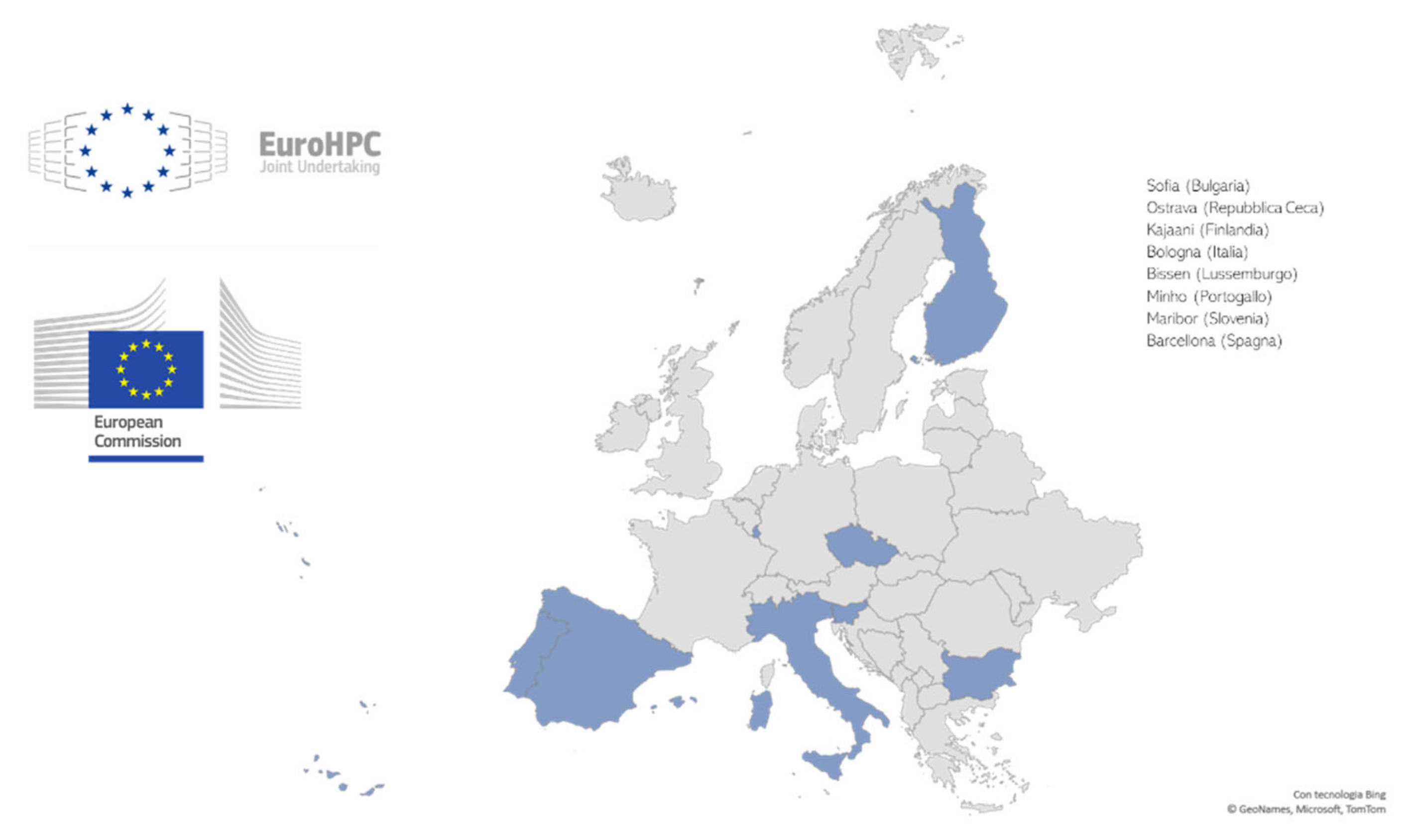
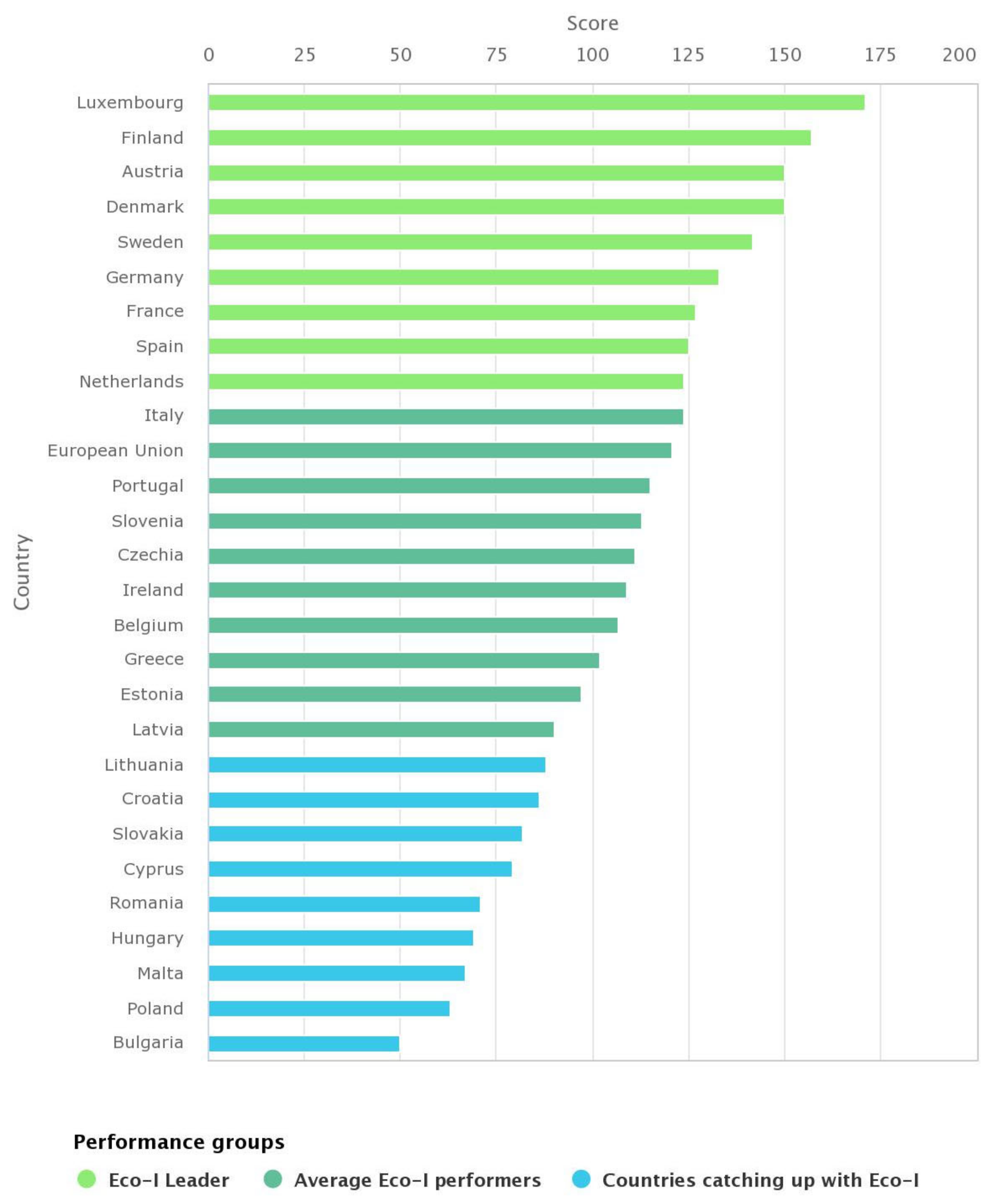
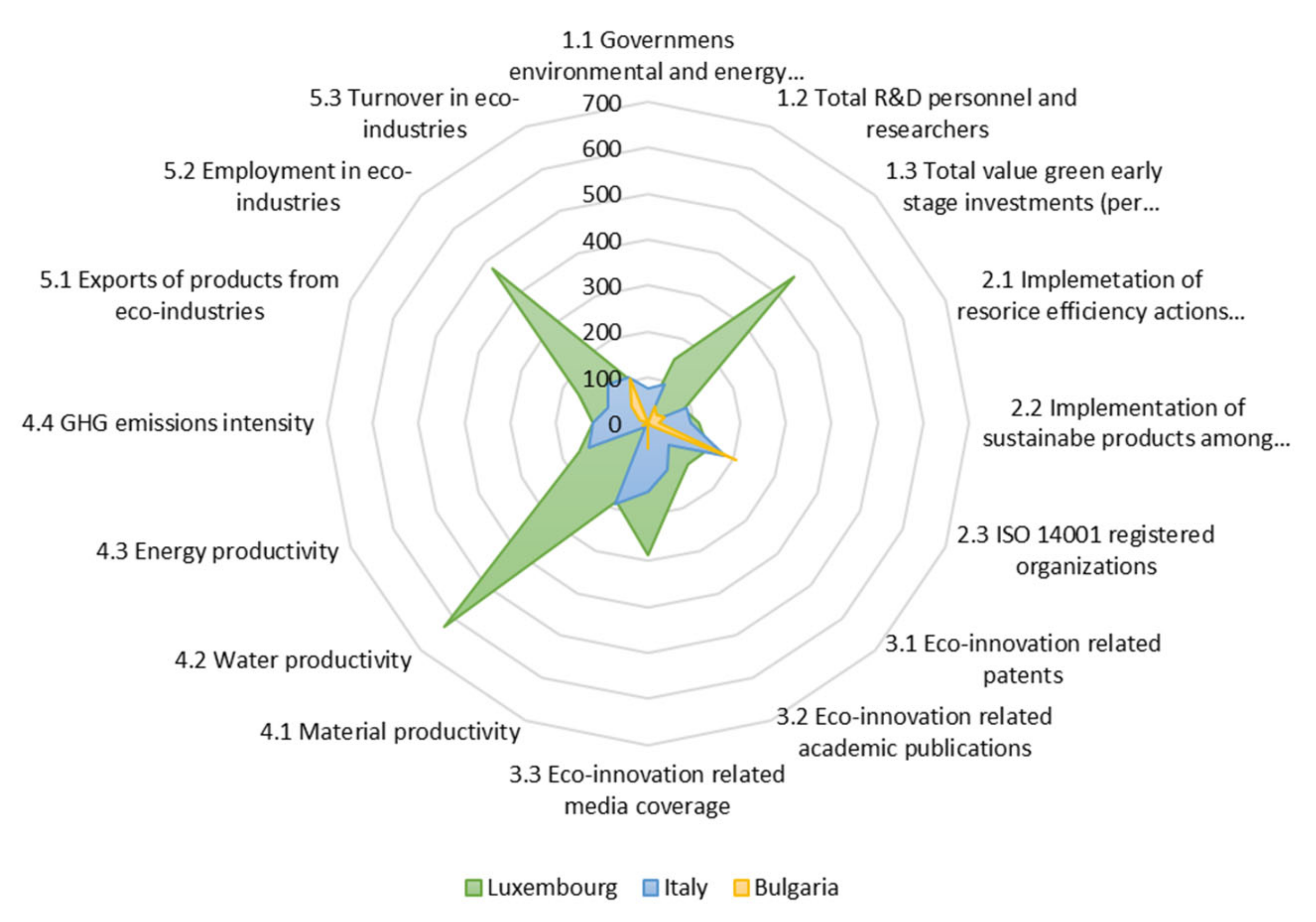
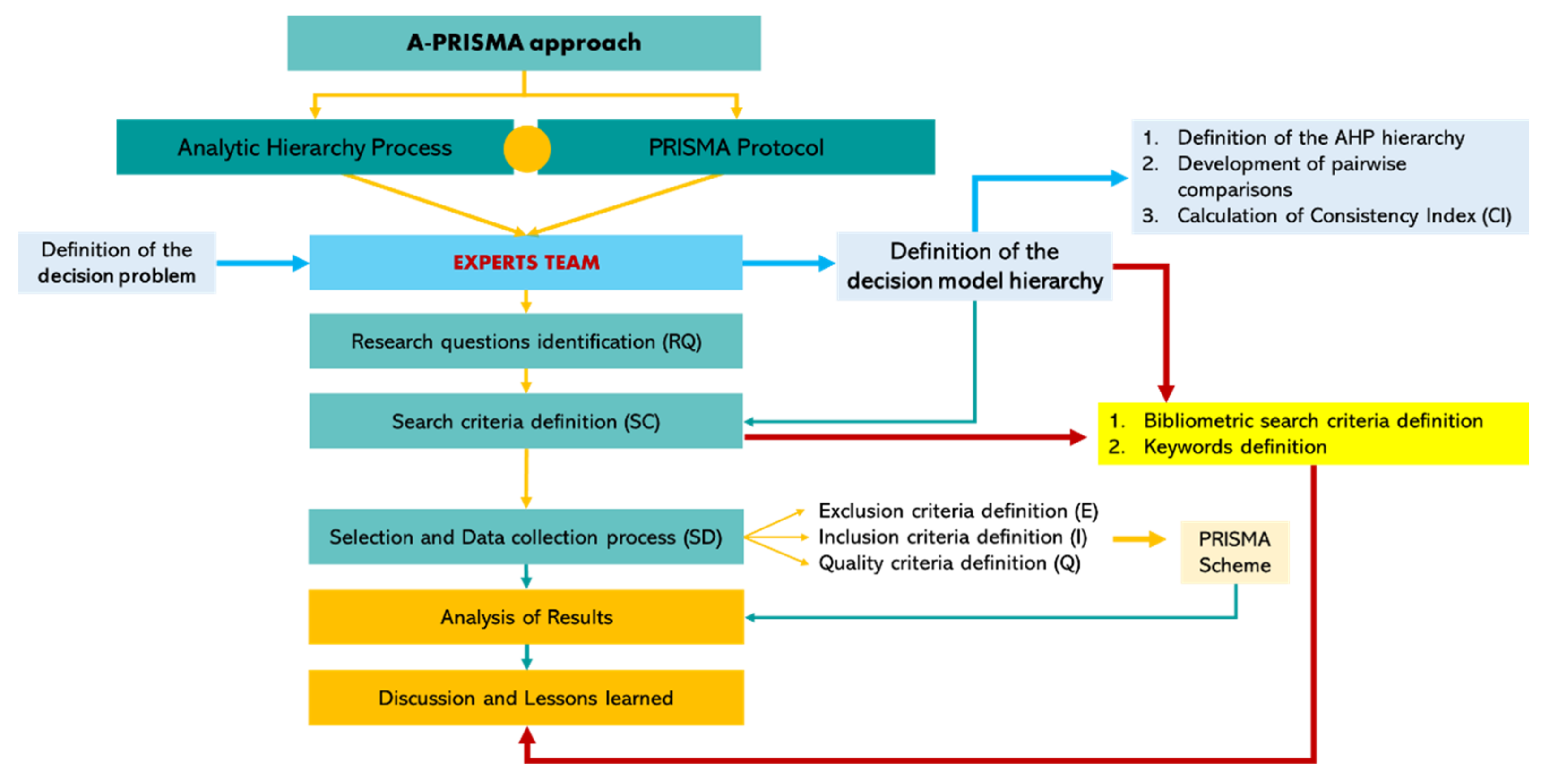

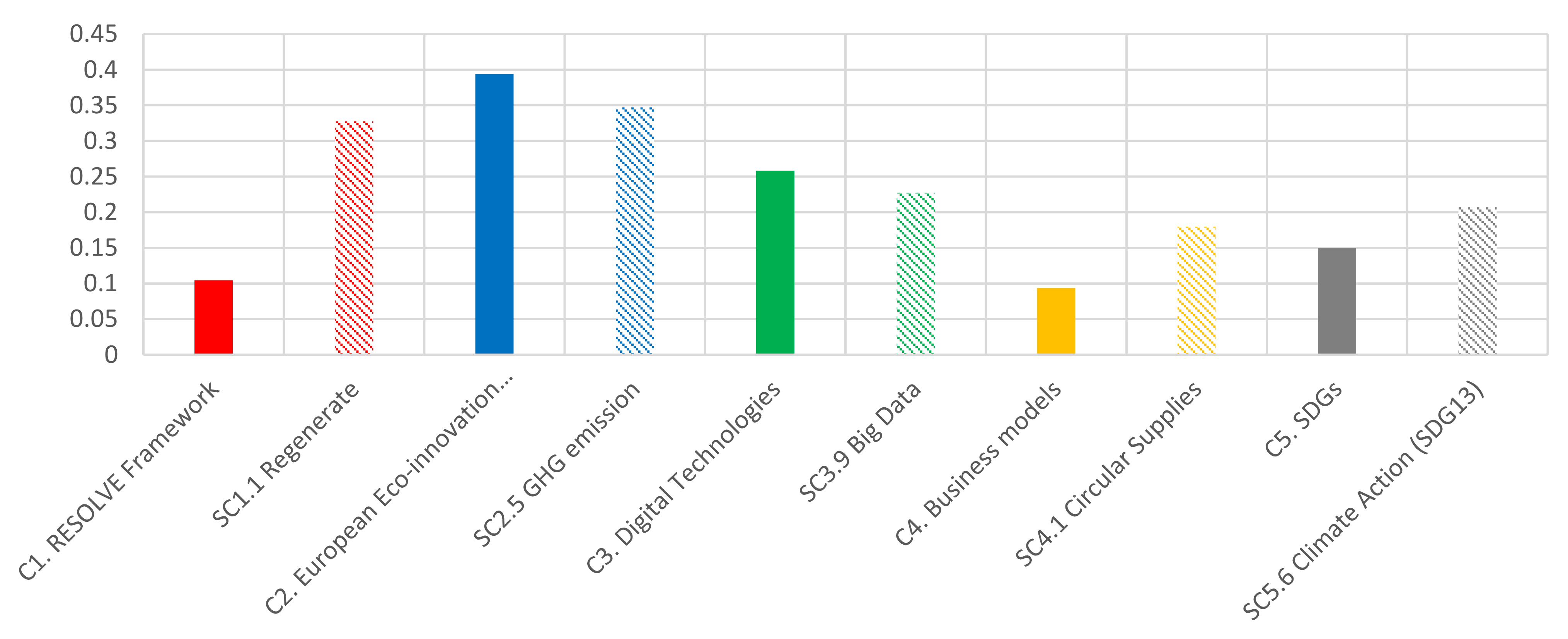
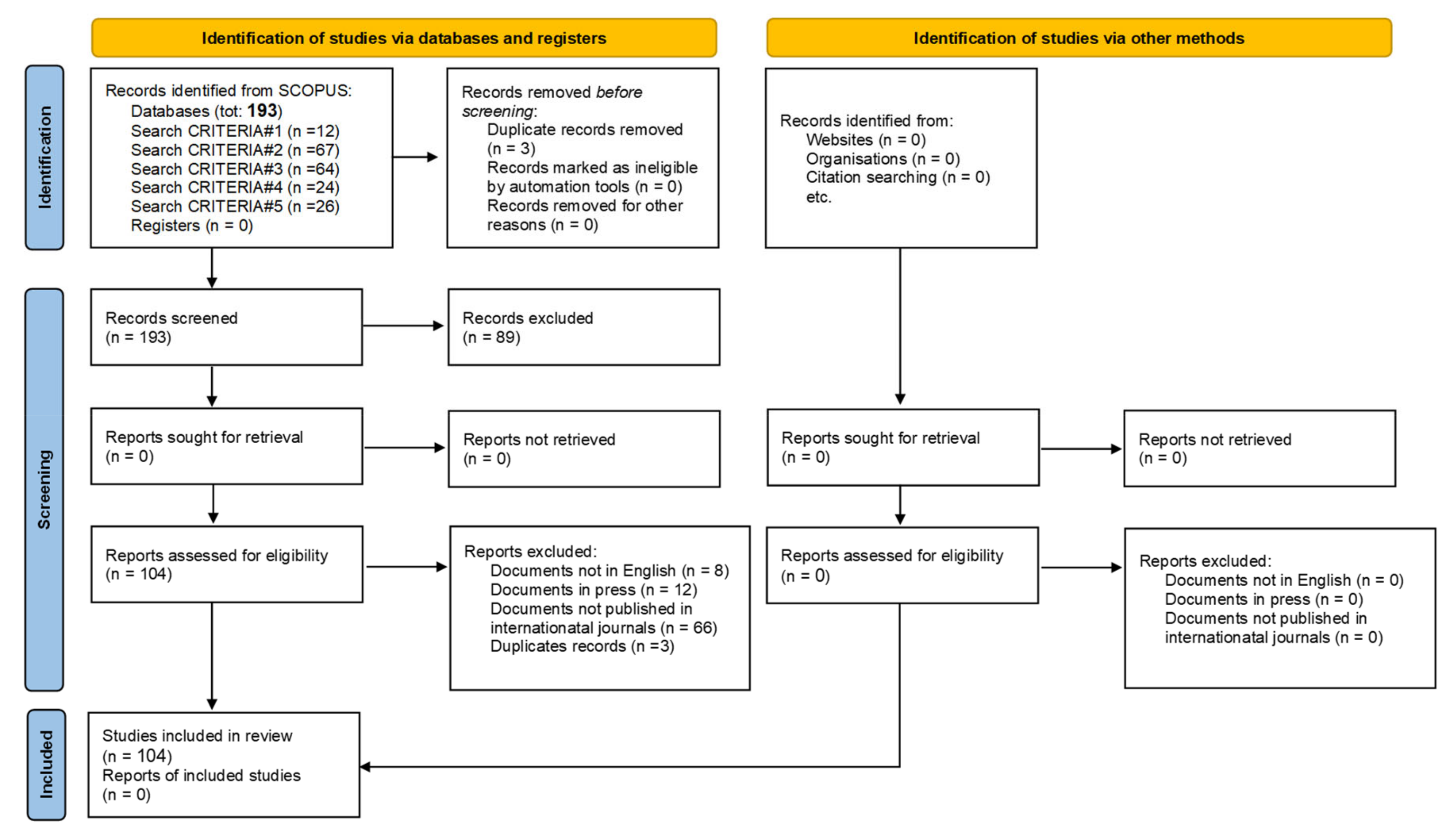
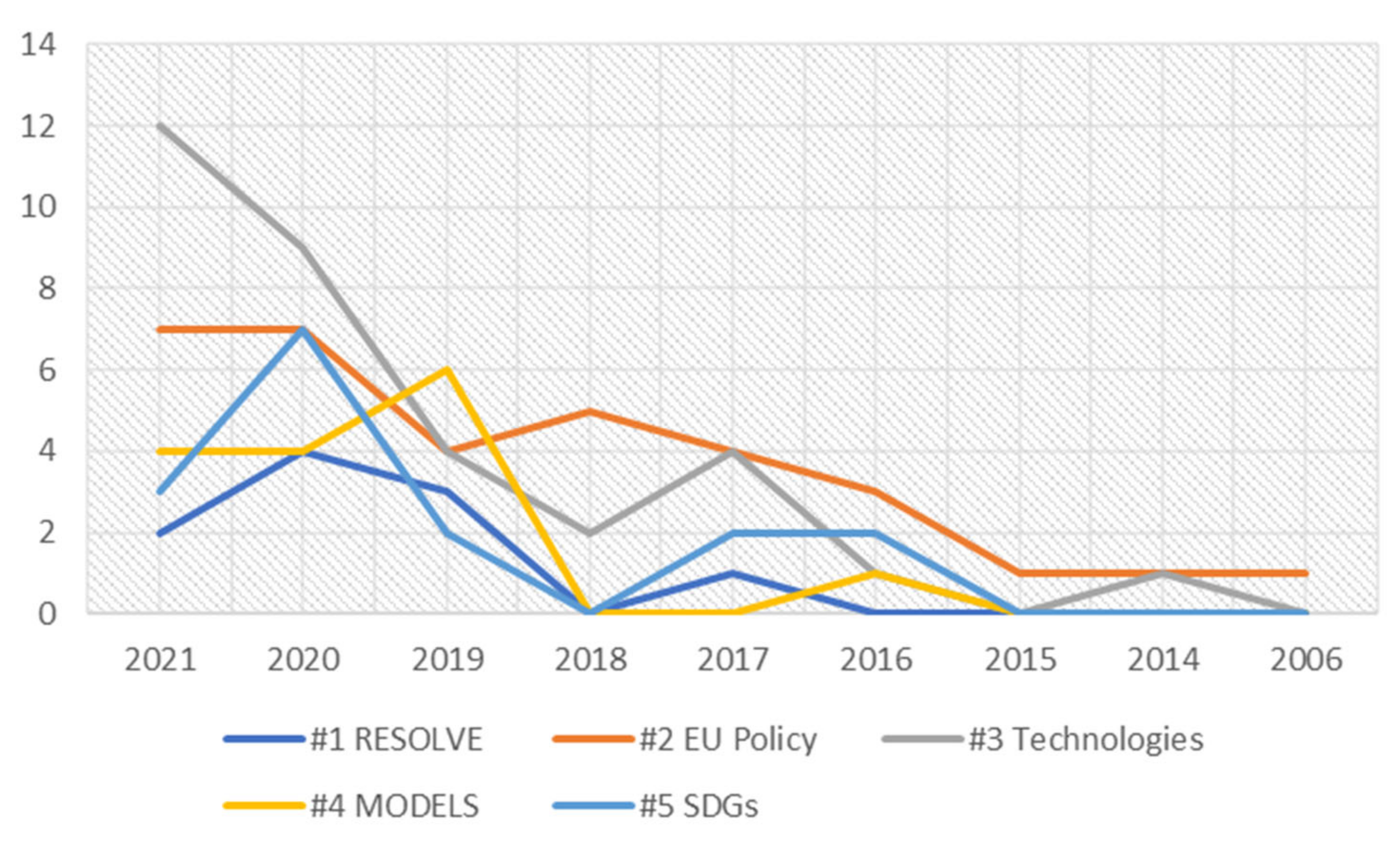
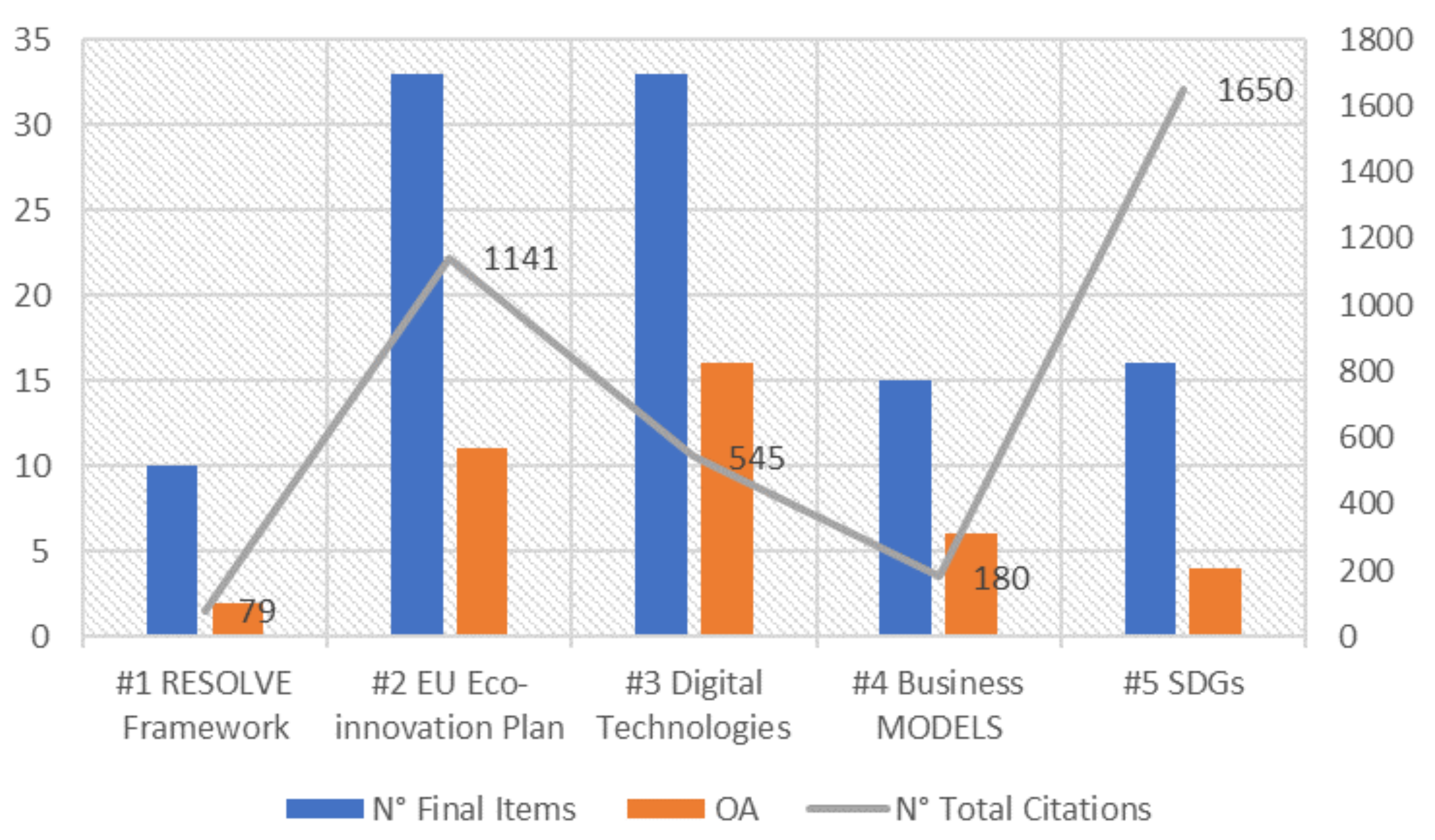
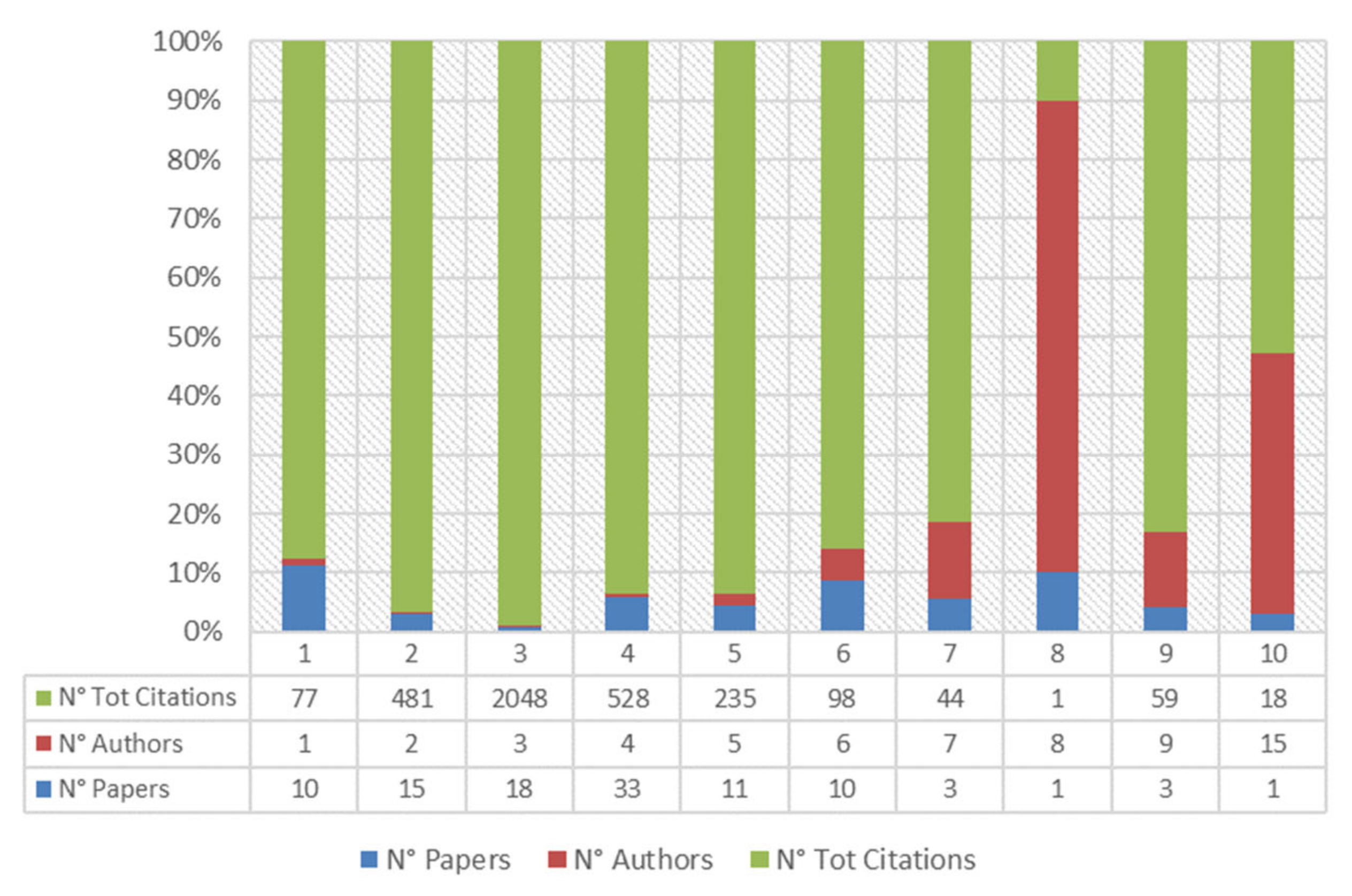
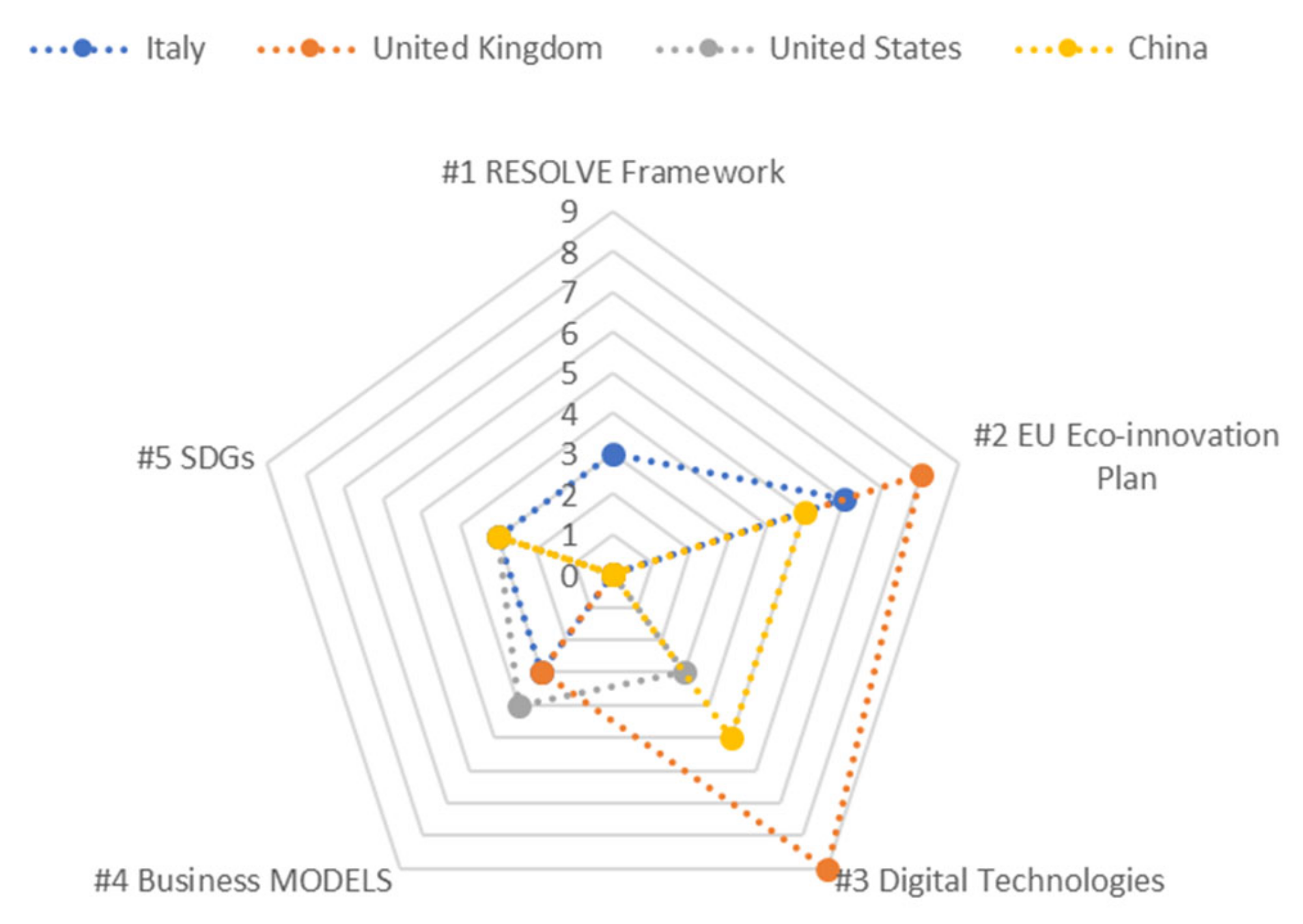
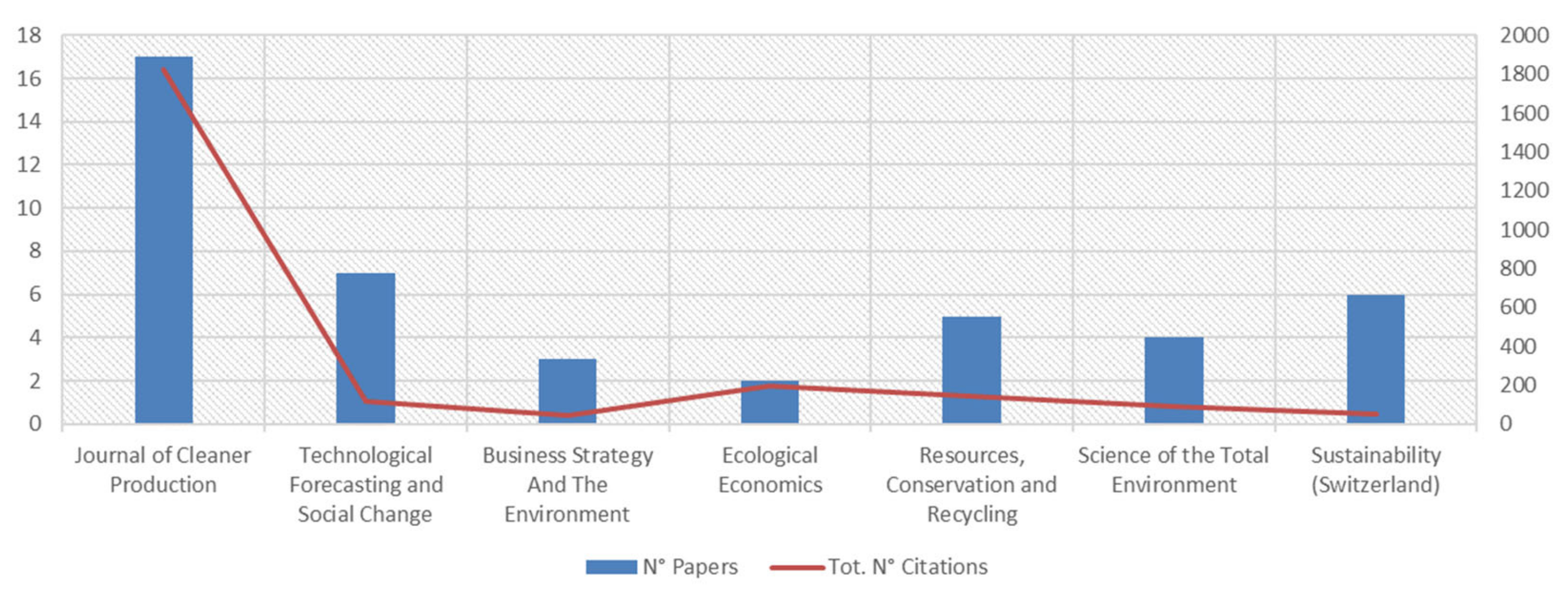

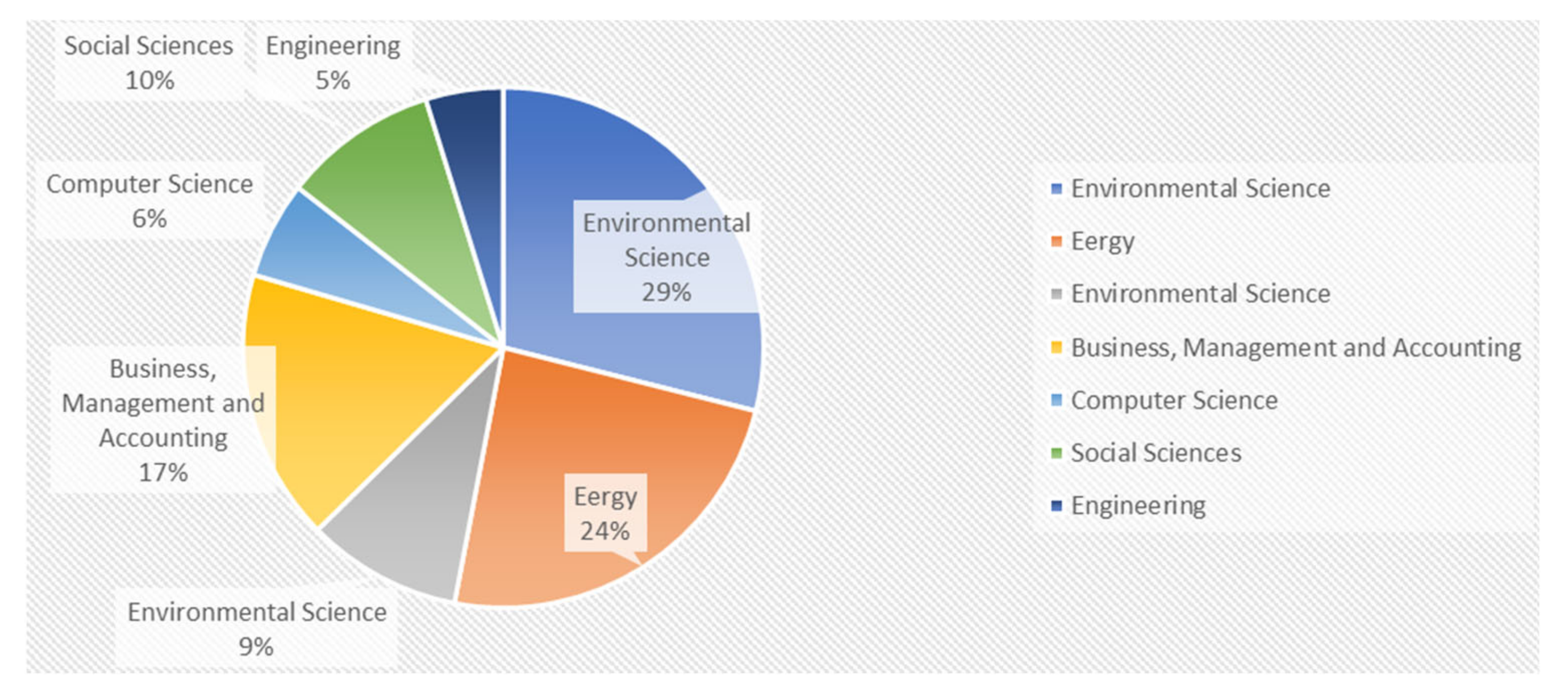
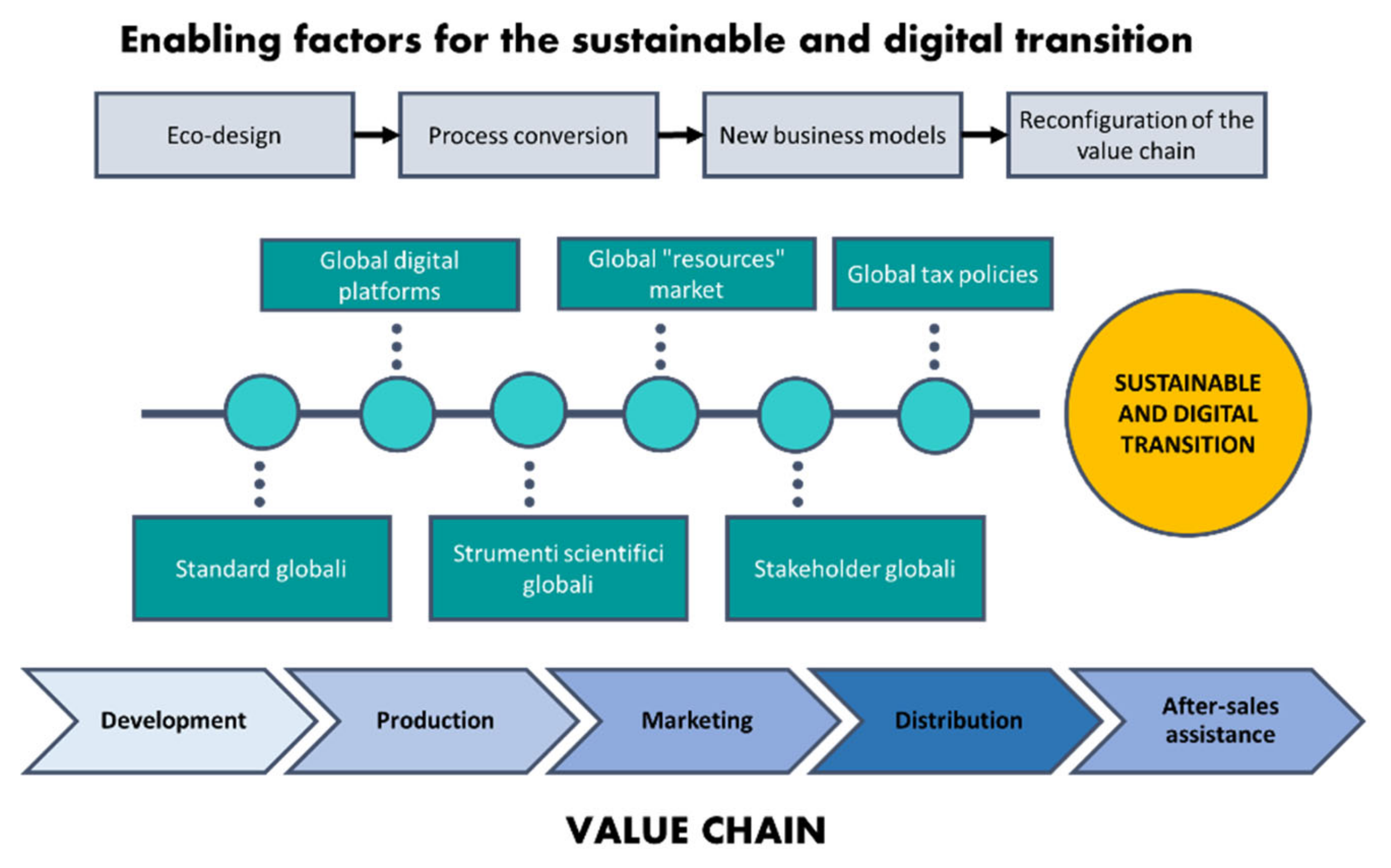
| Bibliometric Search CRITERIA | C1 | C2 | C3 | C4 | C5 | WEIGHT |
|---|---|---|---|---|---|---|
| C1. RESOLVE Framework | 1 | 3 | 4 | 2 | 2 | 0.104 |
| C2. EU Eco-innovation Plan | 1 | 3 | 2 | 3 | 0.393 | |
| C3. Digital Technologies | 1 | 3 | 2 | 0.258 | ||
| C4. Business models | 1 | 2 | 0.093 | |||
| C5. SDGs | 1 | 0.149 | ||||
| Consistency Index | 0.9116 | |||||
| Bibliometric Search SC1 (Keywords) | SC1.1 | SC1.2 | SC1.3 | SC1.4 | SC1.5 | SC1.6 | WEIGHT |
|---|---|---|---|---|---|---|---|
| SC1.1 Regenerate | 1 | 3 | 3 | 2 | 3 | 3 | 0.327 |
| SC1.2 Share | 1 | 2 | 3 | 2 | 2 | 0.216 | |
| SC1.3 Optimize | 1 | 1/2 | 2 | 2 | 0.120 | ||
| SC1.4 Loop | 1 | 2 | 2 | 0.154 | |||
| SC1.5 Virtualize | 1 | 1/2 | 0.084 | ||||
| SC1.6 Exchange | 1 | 0.096 | |||||
| Consistency Index | 0.0689 | ||||||
| Bibliometric Search SC2 | SC2.1 | SC2.2 | SC2.3 | SC2.4 | SC2.5 | SC2.6 | WEIGHT |
|---|---|---|---|---|---|---|---|
| SC2.1 R&D | 1 | 3 | 4 | 2 | 1/3 | 2 | 0.224 |
| SC2.2 Resource efficiency | 1 | 2 | 1 | 1/2 | 1/3 | 0.099 | |
| SC2.3 ISO 14001 | 1 | 1/2 | 1/3 | 1/2 | 0.065 | ||
| SC2.4 Eco-innovation | 1 | 1/3 | 1/2 | 0.100 | |||
| SC2.5 GHG emission | 1 | 3 | 0.347 | ||||
| SC2.6 Eco-industry | 1 | 0.161 | |||||
| Consistency Index | 0.0563 | ||||||
| Bibliometric Search SC3 | SC3.1 | SC3.2 | SC3.3 | SC3.4 | SC3.5 | SC3.6 | SC3.7 | SC3.8 | SC3.9 | WEIGHT |
|---|---|---|---|---|---|---|---|---|---|---|
| SC3.1 Autonomous Robot | 1 | 1/3 | 1/3 | 1/2 | 1 | 1/2 | 1/3 | 1/3 | 1/4 | 0.041 |
| SC3.2 Simulation | 1 | 1/2 | 2 | 2 | 2 | 3 | 2 | 1/2 | 0.150 | |
| SC3.3 System Integration | 1 | 2 | 3 | 3 | 1/2 | 3 | 1/2 | 0.160 | ||
| SC3.4 Internet of Things | 1 | 3 | 2 | 1/2 | 1/2 | 1/3 | 0.080 | |||
| SC3.5 Cyber Security | 1 | 1/3 | 1/2 | 1/2 | 1/4 | 0.045 | ||||
| SC3.6 Cloud Computing | 1 | 1/2 | 1/2 | 1/3 | 0.067 | |||||
| SC3.7 Additive Manuf. | 1 | 2 | 1/2 | 0.136 | ||||||
| SC3.8 Augmented Reality | 1 | 2 | 0.090 | |||||||
| SC3.9 Big Data | 1 | 0.227 | ||||||||
| Consistency Index | 0.0526 | |||||||||
| Bibliometric Search SC3 | SC4.1 | SC4.2 | SC4.3 | SC4.4 | SC4.5 | SC4.6 | SC4.7 | SC4.8 | WEIGHT |
|---|---|---|---|---|---|---|---|---|---|
| SC4.1 Circular Supplies | 1 | 2 | 3 | 2 | 2 | 1 | 1/2 | 2 | 0.179 |
| SC4.2 Regenerative Models | 1 | 2 | 1 | 2 | 2 | 1 | 1 | 0.152 | |
| SC4.3 Encourage sufficiency | 1 | 1/2 | 2 | 1/2 | 1/2 | 2 | 0.089 | ||
| SC4.4 PAAS (results oriented) | 1 | 1 | 2 | 1 | 3 | 0.138 | |||
| SC4.5 Product life extension | 1 | 3 | 1 | 2 | 0.120 | ||||
| SC4.6 Resource value extens. | 1 | 1/2 | 3 | 0.102 | |||||
| SC4.7 Dematerialization | 1 | 2 | 01.63 | ||||||
| SC4.8 PAAS (use oriented) | 1 | 0.053 | |||||||
| Consistency Index | 0.0704 | ||||||||
| Bibliometric Search SC3 | SC5.1 | SC5.2 | SC5.3 | SC5.4 | SC5.5 | SC5.6 | SC5.7 | SC5.8 | WEIGHT |
|---|---|---|---|---|---|---|---|---|---|
| SC5.1 Clean Water (SDG6) | 1 | 2 | 3 | 1 | 1 | 1/2 | 1/2 | 1/2 | 0.116 |
| SC5.2 Clean Energy (SDG7) | 1 | 2 | 1 | 2 | 1/2 | 1/2 | 1/2 | 0.100 | |
| SC5.3 Economic Growth (SDG8) | 1 | 2 | 1 | 1/2 | 1/2 | 1/2 | 0.081 | ||
| SC5.4 Sustainable Cities (SDG11) | 1 | 2 | 1/2 | 1/2 | 1/2 | 0.092 | |||
| SC5.5 Sustainable Cons. (SDG12) | 1 | 1/2 | 2 | 1/2 | 0.099 | ||||
| SC5.6 Climate Action (SDG13) | 1 | 2 | 2 | 0.206 | |||||
| SC5.7 Life Below Water (SDG14) | 1 | 2 | 0.142 | ||||||
| SC5.8 Life on Land (SDG15) | 1 | 0.159 | |||||||
| Consistency Index | 0.0687 | ||||||||
| Bibliometric Search CRITERIA | Search Query (Keywords) | N° of Items without Exclusions | N° of Items with Exclusions |
|---|---|---|---|
| #1 RESOLVE Framework | (TITLE (circular AND economy) AND TITLE (regenerate) OR TITLE (share) OR TITLE (optimze) OR TITLE (loop) OR TITLE (visualize) OR TITLE (exchange) AND TITLE-ABS-KEY (technology)) | 12 | 10 |
| #2 EU Eco-innovation Plan | (TITLE (circular AND economy) AND TITLE (eco AND innovation) OR TITLE (resource AND efficiency) OR TITLE (iso 14001) OR TITLE (ghg AND emissions) OR TITLE (research AND development) OR TITLE (eco AND industry)) | 67 | 33 |
| #3 Digital Technologies | (TITLE (circular AND economy) AND TITLE (autonomous AND robot) OR TITLE (simulation) OR TITLE (system AND integration) OR TITLE (internet AND of AND things) OR TITLE (cyber AND security) OR TITLE (cloud AND computing) OR TITLE (additive AND manufacturing) OR TITLE (augmented AND reality) OR TITLE (big AND data)) | 64 | 32 |
| #4 BUSINESS Models | TITLE (circular AND economy) AND TITLE (circular AND supplies) OR TITLE (regenerative AND models OR TITLE (encourage AND sufficiency) OR TITLE (product AND was AND service) OR TITLE (life AND extension) OR TITLE (dearterialization) OR TITLE (resource AND value) AND TITLE-ABS-KEY (technology)) | 24 | 14 |
| #5 SDGs | (TITLE (circular AND economy) AND TITLE (clean AND water) OR TITLE (clean AND energy) OR TITLE (economic) OR TITLE (sustainable AND cities) OR TITLE (responsible AND consumption) OR TITLE (responsible AND production) OR TITLE (climate AND action) OR TITLE (life AND below AND water) OR TITLE-ABS-KEY (life AND on AND land) AND TITLE-ABS-KEY (technology)) | 26 | 15 |
| Title | Year | Authors | N° of Citations | Journal |
|---|---|---|---|---|
| Environmental and economic implications of recovering resources from food waste in a circular economy | 2019 | Slorach, P.C., Jeswani, H.K., Cuéllar-Franca, R., Azapagic, A. | 48 | Science of the Total Environment |
| Eco-Efficiency Analysis of a Lithium-Ion Battery Waste Hierarchy Inspired by Circular Economy | 2017 | Richa, K., Babbitt, C.W., Gaustad, G. | 64 | Journal of Industrial Ecology |
| A review on circular economy: The expected transition to a balanced interplay of environmental and economic systems | 2016 | Ghisellini, P., Cialani, C., Ulgiati, S. | 1480 | Journal of Cleaner Production |
| Eco-innovation pathways to a circular economy: Envisioning priorities through a Delphi approach | 2019 | de Jesus, A., Antunes, P., Santos, R., Mendonça, S. | 37 | Journal of Cleaner Production |
| When challenges impede the process: For circular economy-driven sustainability practices in food supply chain | 2019 | Sharma, Y.K., Mangla, S.K., Patil, P.P., Liu, S. | 37 | Management Decision |
| Title | Publisher | Cite Score 2020 1 | SJR 2020 2 | Impact Factor 2020 | Percentile |
|---|---|---|---|---|---|
| Journal of Cleaner Production | Elsevier | 13.1 | 1.937 | 9.297 | 98th |
| Technological Forecasting and Social Change | Elsevier | 12.1 | 2.226 | 8.593 | 97th |
| Business Strategy and The Environment | Wiley-Blackwell | 10.3 | 2.123 | 10.302 | 98th |
| Ecological Economics | Elsevier | 9.1 | 1.917 | 5.389 | 95th |
| Resources, Conservation and Recycling | Elsevier | 14.7 | 2.468 | 10.204 | 99th |
| Science of the Total Environment | Elsevier | 10.5 | 1.795 | 7.963 | 96th |
| Sustainability (Switzerland) | MDPI | 3.9 | 0.612 | 3.251 | 84th |
| Authors | Ref. | Year | Type of Publication | Main Focus |
|---|---|---|---|---|
| Contreras-Lisperguer R., et al. | [12] | 2021 | Theoretical/Application | Recycling |
| Tapia C., et al. | [13] | 2021 | Review | Place-based policies |
| Velvizhi G., et al. | [14] | 2020 | Theoretical | Municipal solid waste |
| Atabaki M.S., et al. | [15] | 2020 | Theoretical | Closed-loop supply chain |
| Vanhamäki S., et al. | [16] | 2020 | Case Study | Biological loops |
| Lejarazu-Larrañaga A., et al. | [17] | 2020 | Case Study | Recycling |
| Sharma R., et al. | [18] | 2019 | Case Study | Recycling |
| Roy M., et al. | [19] | 2019 | Case Study | Recycling |
| Conforto R. | [20] | 2019 | Theoretical/Application | Recycling/Recovery |
| Sposato P., et al. | [21] | 2017 | heoretical | Sharing economy |
| Authors | Ref. | Year | Type of Publication | Main Focus |
|---|---|---|---|---|
| Meseguer-Sánchez V., et al. | [22] | 2021 | Review | Degree advancement of the CE |
| Vence X. and Pereira Á. | [23] | 2019 | Theoretical | Eco-innovation |
| Wang N., et al. | [24] | 2018 | Theoretical | Urban sustainability |
| Lee R.P., et al. | [25] | 2017 | Theoretical | Resource efficiency |
| Strothman P., et al. | [26] | 2017 | Theoretical | Resource efficiency |
| Lee R.P., et al. | [27] | 2017 | Theoretical | Resource efficiency |
| Belmonte-Ureña L.J., et al. | [28] | 2021 | Review | SDGs and CE |
| Maldonado-Guzmán G., et al. | [29] | 2021 | Review | Eco-innovation |
| Cainelli G., et al. | [30] | 2020 | Theoretical | Eco-innovation |
| Novelli V., et al. | [31] | 2018 | Theoretical | Eco-innovation |
| Pagotto M. and Halog A. | [32] | 2016 | Theoretical/Application | Resource efficiency |
| Sauvé S., et al. | [33] | 2016 | Theoretical | Environmental protection |
| Lu Y. | [34] | 2014 | Case study | Marine circular economy |
| Johl S.K. and Toha M.A. | [35] | 2021 | Theoretical/Application | Eco-innovation |
| Kiefer C.P., et al. | [36] | 2021 | Theoretical/Application | Eco-innovation |
| Magazzino C., et al. | [37] | 2021 | Theoretical | Municipal solid waste |
| Demirel P. and Danisman G.O. | [38] | 2019 | Theoretical | Eco-innovation |
| Laso J., et al. | [39] | 2018 | Application | Eco-efficiency |
| Ncube A., et al. | [40] | 2021 | Application | Resource efficiency |
| Heath G.A., et al. | [41] | 2020 | Application | Recycling |
| Bartie N.J. et al. | [42] | 2020 | Application | Resource efficiency |
| Garcia-Muiña F.E., et al. | [43] | 2019 | Theoretical/Application | Eco-design |
| Durán-Romero G., et al. | [44] | 2020 | Theoretical | Climate Change |
| Ramkumar S. | [45] | 2020 | Case Study | Eco-innovation |
| Matrapazi V.K. and Zabaniotou A. | [46] | 2020 | Application | Eco-social innovation |
| Charles R.G., et al. | [47] | 2018 | Theoretical/Application | Recovery |
| Stankevičienė J. and Nikanorova M. | [48] | 2020 | Theoretical | Eco-innovation |
| de Jesus A., et al. | [49] | 2019 | Theoretical | Eco-innovation |
| de Jesus A., et al. | [50] | 2016 | Review | Eco-innovation |
| de Jesus A. and Mendonça S. | [51] | 2018 | Review/Survey | Eco-innovation |
| Di Maio F., et al. | [52] | 2017 | Theoretical/Application | Resource efficiency |
| Ma S., et al. | [53] | 2015 | Theoretical/Application | Resource efficiency |
| Taiyang Z., et al. | [54] | 2006 | Case Study | Efficiency of resource |
| Authors | Ref. | Year | Type of Publication | Main Focus |
|---|---|---|---|---|
| Modgil S., et al. | [55] | 2021 | Case Study | Big Data |
| Nobre G.C., Tavares E. | [56] | 2020 | Review | IoT/Big Data |
| Nobre G.C., Tavares E. | [57] | 2020 | Review | IoT/Big Data |
| Górecki J. | [58] | 2020 | Review | Barriers CE |
| Cui Y., et al. | [59] | 2021 | Theoretical/Application | Barriers IoT/ SWARA |
| Jinil Persis D., et al. | [60] | 2021 | Theoretical | Barriers IoT |
| Miaoudakis A., et al.. | [61] | 2020 | Theoretical | Barriers IoT |
| Kazançoğlu Y., et al. | [62] | 2021 | Theoretical/Application | Barriers Big Data/VIKOR |
| Awan U., et al. | [63] | 2021 | Review/Survey | Big data analytics capabilities |
| Kamble S.S., et al. | [64] | 2021 | Review | Big Data-driven/ PROMETHEE |
| Bag S., et al. | [65] | 2021 | Review | Big data analytics capabilities |
| Del Giudice M., et al. | [66] | 2020 | Review/Survey | Big Data/Supply Chain |
| Waudby H. and Zein S.H. | [67] | 2021 | Theoretical/Application | Simulation |
| de la Torre R., et al. | [68] | 2021 | Review | Simulation |
| Li X. and Luo F. | [69] | 2021 | Theoretical/Application | Simulation |
| Utrilla P.N.-C., et al. | [70] | 2020 | Theoretical/Application | Simulation |
| Abadías Llamas A., et al. | [71] | 2020 | Theoretical/Application | Simulation |
| Sauerwein M., et al. | [72] | 2020 | Theoretical/Application | Additive Manufacturing |
| Sauerwein M., et al. | [73] | 2019 | Review | Additive Manufacturing |
| Giurco D., et al. | [74] | 2014 | Theoretical/Application | Additive Manufacturing |
| Wang B., et al. | [75] | 2021 | Theoretical | IoT/Smart waste management |
| Magrini C., et al. | [76] | 2021 | Theoretical | IoT/Blockchain/WEEE |
| Gupta S., Chen H., et al. | [77] | 2019 | Review | Big Data |
| Wang X. | [78] | 2019 | Theoretical/Application | Simulation |
| Charnley F., et al. | [79] | 2019 | Theoretical | Simulation |
| van der Leer J., et al. | [80] | 2018 | Review | Urban planning |
| Hatzivasilis G., et al. | [81] | 2018 | Theoretical | IoT/5G/Cloud |
| Lieder M., et al. | [82] | 2017 | Theoretical | Simulation |
| Lieder M., et al. | [83] | 2017 | Theoretical | Simulation |
| Andreopoulou Z. | [84] | 2017 | Theoretical | IoT |
| Reuter M.A. | [85] | 2016 | Theoretical/Application | IoT |
| Authors | Ref. | Year | Type of Publication | Main Focus |
|---|---|---|---|---|
| Kumar S., et al. | [86] | 2021 | Theoretical | Agriculture supply chain |
| Nandi S., et al. | [87] | 2021 | Theoretical | Supply chain management |
| Nandi S., et al. | [88] | 2020 | Theoretical | Supply chain management |
| Kazancoglu I., et al. | [89] | 2021 | Theoretical | Supply chain management |
| Ciccullo F., et al. | [90] | 2021 | Theoretical | Supply chain management |
| Safiullin M.R., et al. | [91] | 2020 | Theoretical | Supply chain management |
| Alizadeh-Basban N., and Taleizadeh | [92] | 2020 | Theoretical/Application | Remanufacturing |
| Tacchini M., et al. | [93] | 2019 | Case Study | Waste-revaluation |
| Clark N., et a. | [94] | 2019 | Survey | Packaging |
| Sharma Y.K., et al. | [95] | 2019 | Case Study | Food sector |
| Kasulaitis B.V., et al. | [96] | 2019 | Theoretical | Dematerialization |
| Douguet J.-M., et al. | [97] | 2019 | Theoretical | Aggregate sector |
| Daú G., et al. | [98] | 2019 | Theoretical | Supply chain management |
| O’Connor M.P., et al. | [99] | 2016 | Theoretical | Supply chain management |
| Authors | Ref. | Year | Type of Publication | Main Focus |
|---|---|---|---|---|
| Rashid M.I. and Shahzad K. | [100] | 2021 | Theoretical/Application | Waste management |
| Slorach P.C., et al. | [101] | 2019 | Theoretical/Application | Waste management |
| Chen C.-W. | [102] | 2021 | Theoretical | Sustainable cities |
| Llera-Sastres E., et al. | [103] | 2020 | Theoretical | Energy transition |
| Zhou X., et al. | [104] | 2020 | Theoretical | Technological progress |
| Tian X., et al. | [105] | 2020 | Theoretical/Application | Water resource recovery |
| Micari M., et al. | [106] | 2020 | Theoretical/Application | Water resource recovery |
| Kleines L. | [107] | 2020 | Theoretical | Waste management |
| Mathur N., et al. | [108] | 2020 | Theoretical/Application | Material recovery |
| Lee D.-H. | [109] | 2020 | Theoretical | Energy transition |
| Chen W., et al. | [110] | 2019 | Theoretical | Material recovery |
| Stadler M.M., et al. | [111] | 2017 | Theoretical/Application | Water resource recovery |
| Roest K., et al. | [112] | 2016 | Theoretical/Application | Water resource recovery |
| Richa K., et al. | [113] | 2017 | Theoretical/Application | Material recovery |
| Ghisellini P., et al. | [11] | 2016 | Theoretical | Resource efficiency |
| Authors | Empirical Evidence | Main Challenges |
|---|---|---|
| #1. RESOLVE Framework SC1.1 Regenerate | Regenerate and proper waste disposal is among the key issues analyzed by the scientific community | Lifecycle of products: from design, to production methods, to their disposal. The aim is to ensure that waste is avoided and that the resources used are kept in the digital circular economy for as long as possible. Legislative measures: favor interventions to establish a new “right to reparation” for the consumer. |
| #2. European Eco-innovation Action Plan SC2.5 GHG emission | The scientific community agrees that the starting point for the implementation of a credible strategy to reduce GHG emission must be quantified, following recognized scientific principles, valid for everyone, and obtaining a comparable and repeatable result over time | Interconnected databases: For climate protection, big data and AI could make it possible to develop predictive models capable of identifying the possible effects of climate change and assessing the effectiveness of law enforcement policies. KPIs: Measuring emissions helps to disclose and engage with “stakeholders”, managing to communicate transparently how the issue of climate change is addressed and to demonstrate the sustainability of one’s business model over time. |
| #3. Digital Technologies SC3.9 Big Data | According to what emerges from the scientific community, big data and data analytics are enabling factors to contribute to sustainable development | Sustainable industry: Through Biga data, predictive maintenance of machinery could be enabled, which would prevent breakdowns, thus extending the life of the machine and reducing waste of energy and products. In addition, big data and data analytics are enabling factors to contribute to energy efficiency. |
| #4. Business models SC4.1 Circular Supplies | Researchers agreed that companies can be active promoters of change, rather than just undergoing it | Territory: Investing in the national territory projects in favor of the environment and the community that welcomed them and the communities most in need. Realities engaged in the reduction and recycling of the resources necessary for production, as well as in the efficiency of production processes. |
| #5. SDGs SC5.6 Climate Action (SDG13) | Academics around the world argue that promoting effective action for climate change requires not only climate data, but also comprehensive information on human behavior | Climate Chain: Big data could help fight climate change as it can offer us an answer on how humans affect and are affected by the effects of climate change. With this information it is possible to improve and innovate on sustainability issues and in the ability we have to recover and adapt. |
Publisher’s Note: MDPI stays neutral with regard to jurisdictional claims in published maps and institutional affiliations. |
© 2021 by the authors. Licensee MDPI, Basel, Switzerland. This article is an open access article distributed under the terms and conditions of the Creative Commons Attribution (CC BY) license (https://creativecommons.org/licenses/by/4.0/).
Share and Cite
De Felice, F.; Petrillo, A. Green Transition: The Frontier of the Digicircular Economy Evidenced from a Systematic Literature Review. Sustainability 2021, 13, 11068. https://doi.org/10.3390/su131911068
De Felice F, Petrillo A. Green Transition: The Frontier of the Digicircular Economy Evidenced from a Systematic Literature Review. Sustainability. 2021; 13(19):11068. https://doi.org/10.3390/su131911068
Chicago/Turabian StyleDe Felice, Fabio, and Antonella Petrillo. 2021. "Green Transition: The Frontier of the Digicircular Economy Evidenced from a Systematic Literature Review" Sustainability 13, no. 19: 11068. https://doi.org/10.3390/su131911068
APA StyleDe Felice, F., & Petrillo, A. (2021). Green Transition: The Frontier of the Digicircular Economy Evidenced from a Systematic Literature Review. Sustainability, 13(19), 11068. https://doi.org/10.3390/su131911068







